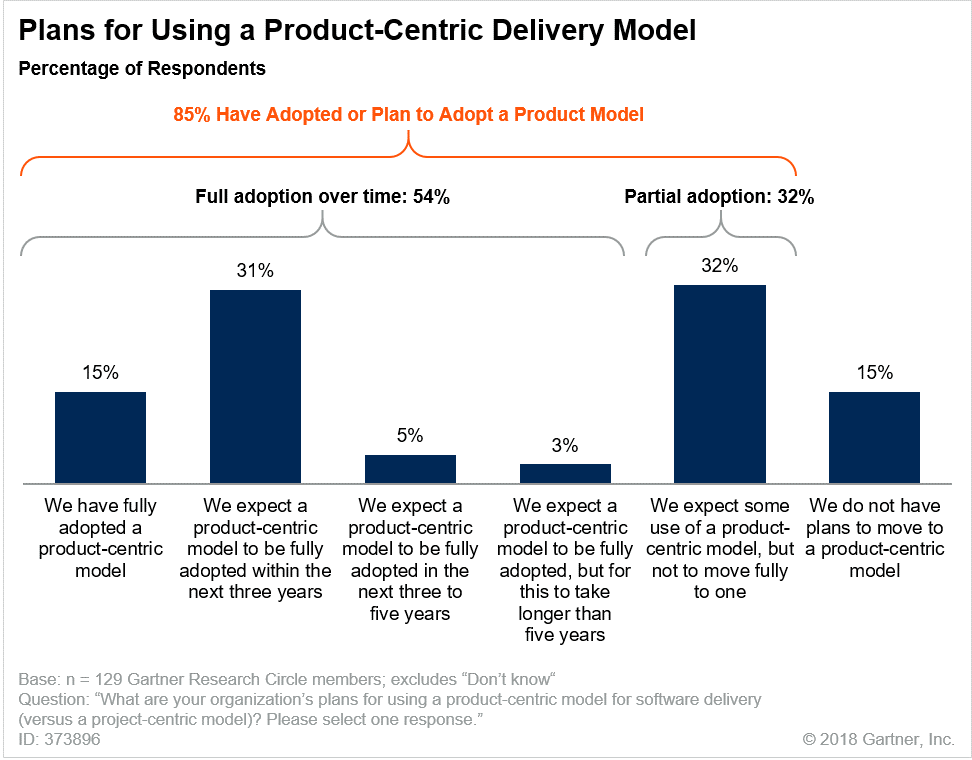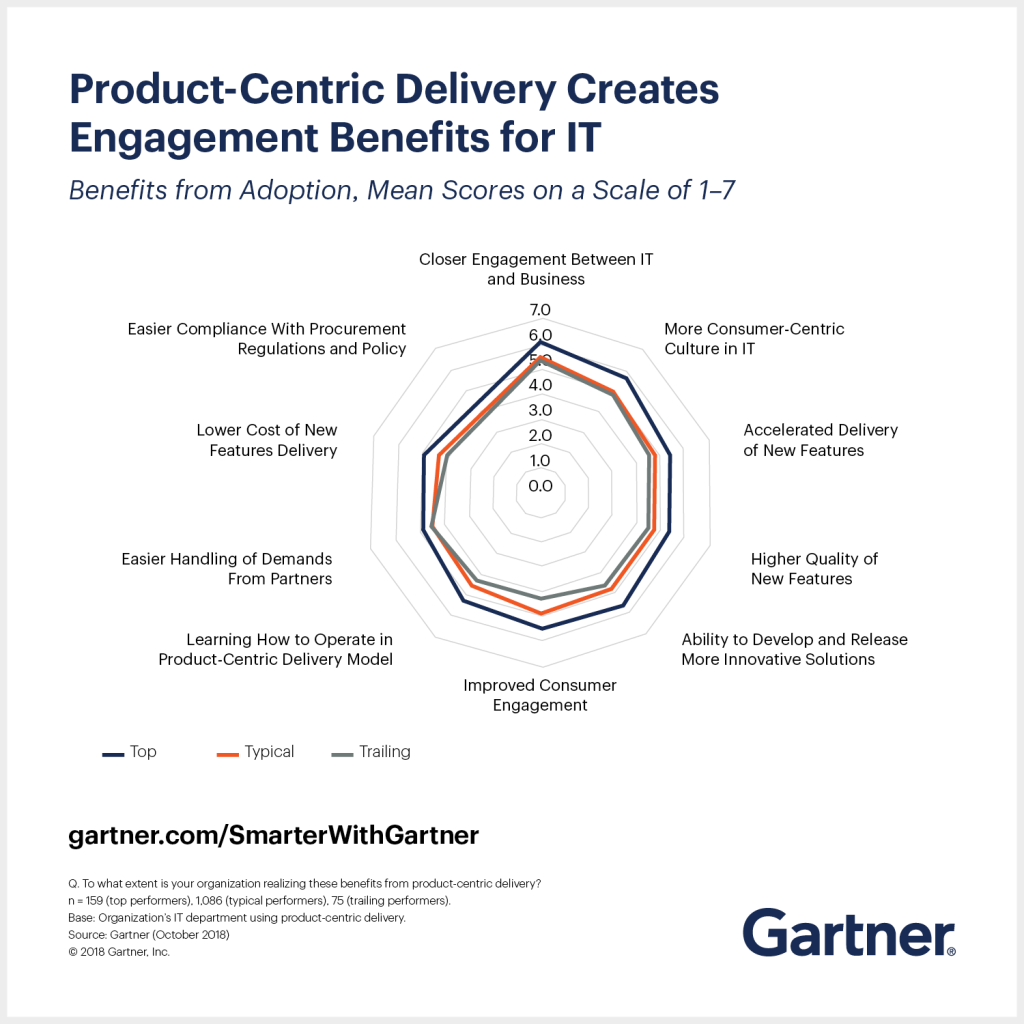A project is defined as a temporary endeavor undertaken to create a complete product or service. The definition explicitly mentions that a project mindset is a temporary approach to launching a product and moving on to the next, thus leading towards losing the continuity of thought.
My philosophy is that everything starts with a great product…
Well, it’s not me who stresses upon a product mindset. Instead, it’s a linchpin of Steve Job’s business strategy that helped him shape Apple’s digital innovation, thus moving away from project-based episodic delivery. Not just Apple, other big brands like Tesla and Netflix focus on no “launch and move on” mentality, too, thereby emerging as a continually evolving brand, aiming to build lovable products.

Apart from these big names, 55% of organizations surveyed by Gartner are moving towards full adoption of the product-centric application model by defining new architectures and tools (39%), investing in DevOps software development methodologies (35%) and hiring workers with new skills (32%), to name a few.
What is a Product Mindset?
A product-centric delivery model demands focus on the eventual goals of an organization rather than short term achievements. Here the teams give more weightage to the final outcome and of the project rather than factors such as timelines and budgets. The goal is to build up the ROI. Hence the success metrics of product mindset principles are around creating a great customer experience, building a roadmap that ensures frequent releases, and focusing on building the right product. Organizations are increasingly realizing the benefits of product over the project mindset.

We respect your privacy. Your information is safe.
What is a Project Mindset?
A project mindset is an approach to achieve certain activities and purposes in a set period of time. It can be conducted through a solid collaboration among teams to realize the objective. For many organizations, a project mindset means hiring teams to meet deadlines, budgets, and other constraints, to focus on an initial plan and the pre-decided task. A project might be eventually built within the set restrictions but can often turn out to be an invaluable product since the focus is oriented towards task management – a central differentiating element between project vs. product management.
Why are Businesses Choosing Product Mindset Over Project Mindset
If we compare the product vs. project mindset, projects progress with the silo approach. On the other hand, product mindset witnesses quicker business outcomes, improved customer experiences, reduced friction within the organization, and more flexibility.
32% of the businesses identified in the Gartner survey claim that ‘a need to deliver more quickly’ is their primary driver of adoption of a product-centric application approach.
The heightened shift from project to product mindset has paved the way for businesses to enhance how they conduct software engineering, resulting in faster time-to-market, lower cost, and elevated code quality.
1. Increased Software Delivery Velocity
Agile and DevOps is a best-in-class practice integrated mostly to Agile Development projects in order to increase software delivery velocity, improve service reliability, and build shared ownership among software stakeholders. Organizations implementing the DevOps solutions release new software 63% more frequently.
2. Drive and Enable the Ideation Process
With the market insights, product managers get empowered to drive and enable the ideation process and to assess ideas for their market fit. Enabling this during the ideation phase results in earlier participation of IT professionals such as architects, engineers, data scientists, and UX designers, leading to an increased IT ownership of business-enabling ideas.
3. Improved Customer Experience
A product-centered organization recognizes the customer at the core of the product, with a perception that a good customer experience develops and maintains the product. The product manager understands and meets the customer needs through the product management toolset: market and competitor research, customer segmentation and personas, and focus group testing of products.

Steps to Become an Organization with Product-Mindset
The project-centric businesses cannot accommodate the uncertainty, flexibility, and speed needed to steer innovation in products, services, and customer experiences in today’s dynamic marketplace. Thus, the shift towards becoming a product-centric organization should focus on areas, discussed in this section, where there is scope to drive digital initiatives.
66% of leaders think that they are digitally transforming their business; only 11% of CEOs are actually doing so.
1. Synergize the Business-IT Partnership
Identify product-centric roles in your Agile development company: capability leader, product manager, Agile coach, and DevOps architect.
- Capability leaders and product managers typically come from business lines
- Agile coach and DevOps architect come from IT lines
Bringing capability leaders and product managers on the table from the business is the foremost step to initiate continuous collaboration.
2. Agile Product Funding
An organization with a product mindset starts to fund products incrementally and iteratively. It provides flexibility that enables experimentation and allows the team to adapt to changes in business priorities. The built-team ensures that the organization is allocating funding responsibly to steer the agility and innovation to achieve strategic objectives.
Instead of prolonged approval processes that stretch the time to market, which is a routine in a project-centric approach, you can shift funding and balance capacity across initiatives by providing visibility into performance and connecting strategy to delivery.
3. The Shift from Focusing on Data
In today’s dynamic and ever-evolving digital world, where data usage is increasing daily, the role of chief data officer (CDO) should be to shift their focus from data and analytics projects to steering a product-centric organization. This new CDO with the new role of adopting the product-mindset for an organization can be called CDO 4.0, as advised by the Gartner research report.
- CDO 1.0: The main focus was on data management
- CDO 2.0: The main focus was on analytics
- CDO 3.0: The main focus was on digital transformation
The CDO 4.0 focuses on products, and on managing, profit and loss instead of just being responsible for driving data and analytics projects and programs.
Product Mindset vs. Project Mindset- Final Thoughts
The digital business carries a broader scope than constructing sophisticated façades around existing monolithic applications while perhaps modernizing the existing technology infrastructure, traditional processes, and the technologies of yesteryear.
Deciding on products over projects requires holistic organizational change management resulting in an organizational change that reflects a culture of valuing end-user experience and customer delight. Instilling a product-centric approach and collaborating with a product development company helps align IT organizational structure with product-centric roles and fortify the business partnership, thereby creating new business models with innovative products and services and expanding business through more significant digital opportunities.




